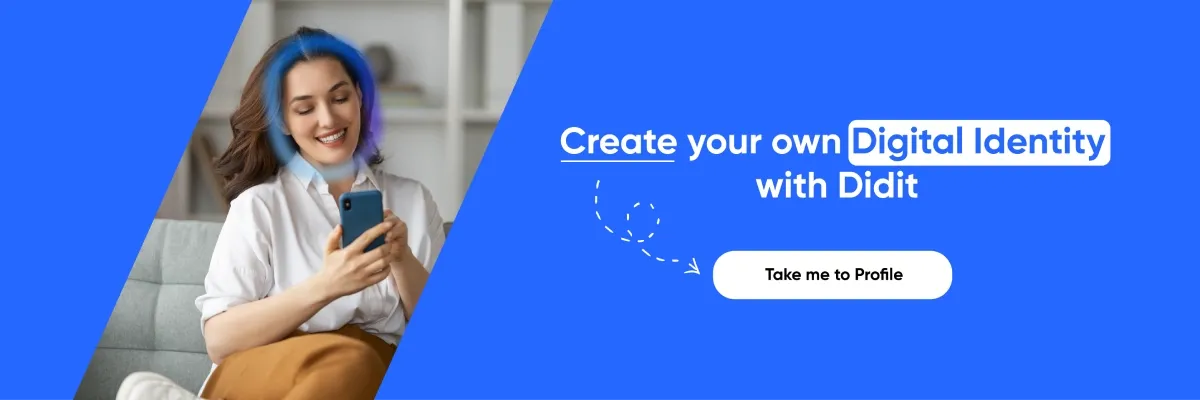Key takeaways
Evolution of Digital Identity: The digital transformation has made identity authentication crucial in the internet era. Didit emerges as a key innovation, using NFC technology, blockchain, and artificial intelligence to redefine digital interaction and ensure humanity in online connections.
Online Authenticity and Identity Verification: Growing concerns about online authenticity and the rise of cyber fraud underscore the need for robust and reliable verification systems. Didit offers a secure and private solution, raising the standard for authentic digital interactions.
Humanity Tests: In a digital world populated by bots, humanity tests like CAPTCHAs become crucial. Didit goes further, providing an advanced verification method that ensures genuinely human interactions online.
Didit as a Digital Identity Innovation: Didit not only validates digital identity more effectively than traditional methods but also allows the validated identity to be reusable, offering a safer and more private digital environment.
For generations, humanity has gazed upon the cosmos, wondering if we are alone in the universe. This enduring concern, "Are we the only conscious beings that exist?", has marked our quest for knowledge. However, in the current era, driven by numerous (and astounding) technological advancements, these philosophical queries have evolved. Today, we face more immediate and personal questions, especially in the realm of digital interaction. "Is the one on the other side a real person or just a bot?" has become a common query in our everyday online life.
This shift in our concerns reflects a new reality: the growing importance of establishing a verifiable digital identity. As we delve deeper into the digital world, the need to ensure we are interacting with real human beings, and not automated entities, becomes increasingly critical. Hence the relevance of humanity tests, mechanisms designed to ensure that internet connections and communications are genuinely human.
The internet was missing an identity layer. Fortunately, we Didit.
The Evolution of Identity in the Digital Age
In the early days of the internet, awareness of a digital identity was almost science fiction. Back then, the net was a vast ocean of possibilities, a space where one's identity could be as fluid and changing as the waves of the sea. It was a new and exciting world, where anonymity was the usual norm. This digital freedom, so stimulating at its onset, soon presented its own challenges: How can we truly know who is on the other side of the screen?
As technology advanced and online interactions multiplied, digital identity began to take a more concrete form. Social networks asked for our names and photos, online stores required our addresses and payment details, and every new registration on a service or app seemed to claim another piece of our real selves. This new digital world not only became a reflection of our everyday life, but it started to define it while fragmenting our identity into thousands of pieces scattered across the web.
But with every technological advance came new challenges. The thin line between real and virtual began to blur. Bots, computer programs designed to mimic human behavior, began to proliferate on social networks, sometimes indistinguishable from flesh-and-blood users. Conversations with virtual assistants became so natural that we often forgot we were talking to algorithms and not people. This evolution not only amazed us with its ingenuity and sophistication, but also made us reflect: in this new digital world, how can we protect and authenticate our true identity?
This question leads us to the current situation we find ourselves in: an era where digital identity is as crucial as the real one, and the need to prove that we are humans and who we say we are online is more important than ever. In this context, the evolution of digital identity is not just a matter of technology, but also of humanity.
Online Authenticity: The Challenges of Validation and Identity Verification on the Internet
The issue of online authenticity has become a central concern, not just for individuals, but also for businesses and governments. Each click, each interaction on the net, carries the concern of not knowing if the one on the other side is a human or not.
Online fraud and identity theft are growing problems. Stories about people whose identities have been stolen, or businesses that have suffered cyber-attacks, are no longer exceptions; they are becoming the norm. This atmosphere of uncertainty has increased the need for robust and reliable verification systems. It's not just about protecting data or financial transactions; it's about humanizing the internet.
Identity authentication, in this context, is a delicate balance between privacy and security. On one hand, we want to maintain our right to anonymity and online privacy; on the other hand, we need to ensure that the person we're interacting with, whether on a social network, a financial transaction, or even in an online game, is really who they claim to be. This duality represents a constant challenge in the design of digital identification systems.
And this is where everyday examples come to life. Imagine the simple act of buying something online. In the past, a transaction was based on the implicit trust that the seller and buyer were who they claimed to be. Today, that transaction involves layers of verification: passwords, text messages with codes, biometric checks... Each step is a reminder that in the digital world, identity verification is an imperative need.
These challenges not only make us question how we protect our identity but also how we can remain authentic in a space where authenticity is often questioned. In this ever-changing world, the question remains: How can we be ourselves safely?
Humanity Tests: Ensuring the Humanity of Interactions in a Digital World
To address this question, a revolutionary yet vital concept for the positive health of our online interactions emerges: humanity tests. These are bastions of our identity and authenticity in a world increasingly governed by algorithms and machines. But what exactly are these humanity tests, and why have they become so important?
Humanity tests are, at their core, mechanisms designed to differentiate between human users and automated bots. An example is CAPTCHAs, those little puzzles we must solve to prove we're not computer programs. The thing is, despite the continuous evolution of these methods, they are easily bypassed by well-trained artificial intelligences.
The significance of these tests goes beyond the mere security of an account or transaction. They represent an effort to preserve human integrity in a space increasingly populated by digital entities: the result of generating an identity layer on the internet. In a world where online interactions can have significant real-world repercussions, ensuring these interactions are entirely human is more crucial than ever.
But how do you balance the need for security with ease of use? Too much security can make online interactions cumbersome and frustrating, while too much flexibility can leave gaps for fraud and deception. Finding the middle ground is a constant challenge for developers and designers of digital identification systems. And that is what Didit has achieved with its technology, redefining the way we relate on the internet, whether with other people or entities.
Didit as a Leader in Digital Identity Innovation
But what makes Didit so crucial in this era of digital interactions, and how is it redefining the way we interact online? The essence of this technology lies in its unique approach to validating identity in the digital space.
Unlike traditional methods, which are often susceptible to being outsmarted by advanced artificial intelligences, Didit offers a more secure, private, and scalable solution. For validating digital identities, this tool uses NFC technology, blockchain, and artificial intelligence. This combination not only overcomes the limitations of traditional methods, prone to manipulation by advanced I.A. systems, but also raises the standard of security and privacy in the digital realm.
How does Didit work? Through the use of the NFC chip of an identity document or passport, Didit reliably confirms the humanity of the person, while blockchain technology provides an unprecedented level of privacy and decentralization. Whether on social networks, commercial transactions, governmental interactions, or in any of the other potential uses of Didit, this solution provides a solid foundation for ensuring the authenticity and integrity of these interactions.
Strengthening Digital Identity with Didit
Didit's technology goes beyond simple verification, as it allows the validated identity to be reusable in other services integrating this technology. It offers a promise of safer, more authentic, and private interactions. Whether you're navigating social networks, conducting online transactions, or engaging in digital environments, Didit ensures that your identity is protected and that your interactions are genuinely human. This additional security contributes to building a more secure and trustworthy digital environment for everyone.
If you're ready to take the first step towards protecting your digital identity and enjoying the advantages that Didit offers, don't wait any longer. Click the button below to start exploring a world of possibilities with Didit, where your safety and privacy are the priority.

